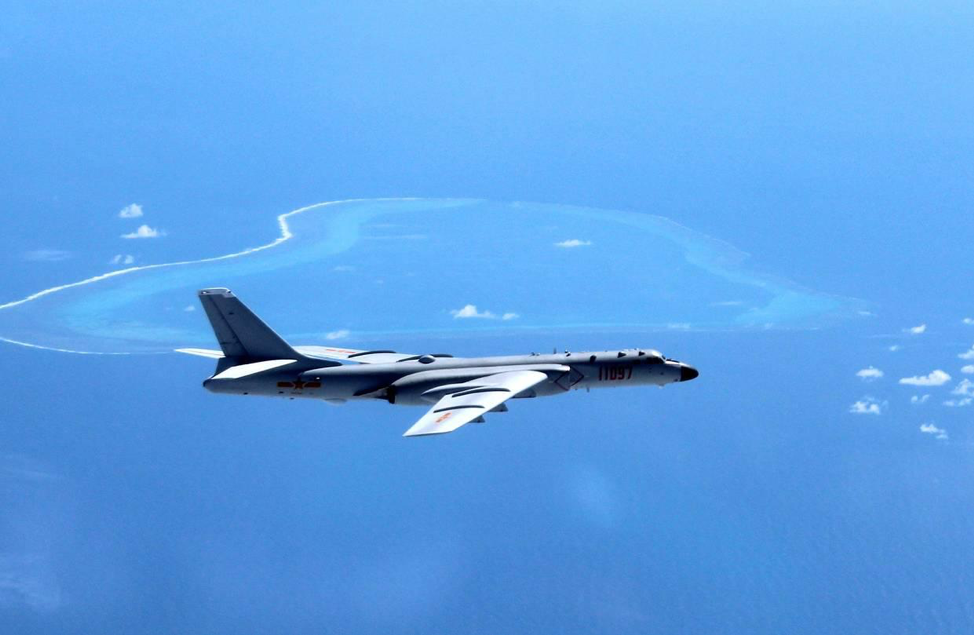Water Wars: Bombers Away
On May 18, the China Daily reports, the People’s Liberation Army Air Force landed multiple H-6K bomber aircrafts on the disputed Woody Island in the South China Sea. This is the first time China has publicly landed its bombers on any of the features in the South China Sea region.

Published by The Lawfare Institute
in Cooperation With

On May 18, the China Daily reports, the People’s Liberation Army Air Force landed multiple H-6K bomber aircrafts on the disputed Woody Island in the South China Sea. This is the first time China has publicly landed its bombers on any of the features in the South China Sea region.
The China Daily quoted Wang Yanan, editor of Aerospace Knowledge, as saying that the deployment of bombers on the island would dramatically extend China’s operational range and maritime defense parameters. It also released a video taken by the People’s Liberation Army Air Force of the bombers practicing take-off and landing procedures on the island.
The H-6K is a more advanced version of China’s H-6 nuclear-capable strategic bombers: The basic bombers have a range of about 1,000 nautical miles, while the H-6K extends that range to 1,900 nautical miles. The H-6 is itself based on the older Soviet Tu-16, though upgraded with modern electronics and precision weapons.
Conducting its own analysis of the aircrafts’ location, the Asia Maritime Transparency Initiative notes that the basic H-6’s combat radius of 1,000 nautical miles would allow China to strike anywhere in the South China Sea as well as most of the Philippines. The upgraded H-6K, with a range of 1,900 nautical miles, would have an even further reach. The AMTI further reports that hangers for military-grade aircrafts have already been built on Fiery Cross, Mischief Reef, and Subi Reef in the Spratly Islands, and that military aircrafts have been spotted on all three of these islands. The AMTI concludes that the placement of bombers on the Spratly Islands, which are significantly further south than Woody Island, would extend China’s operational reach to cover Singapore and much of Indonesia, with upgraded bombers potentially able to strike Guam and northern Australia.
The United States has criticized the deployment, with Pentagon spokesman Lt. Col. Christopher Logan telling Reuters that “China’s continued militarization of disputed features in the South China Sea only serves to raise tensions and destabilise the region.” On May 23, the United States took action on this “continued militarization” by disinviting China from participation in the Rim of the Pacific military exercises planned for June.
The landing of the H-6K bombers is part of a larger pattern of China’s projection of force into the region, coming soon after its April installation of YJ-12B anti-ship cruise missiles and communication-jamming equipment on its three largest bases in the Spratly Islands. The new missiles will allow China to strike vessels up to 295 nautical miles from its bases in the Spratly Islands, representing a significant upgrade over its previous missile range.
In Other News ...
In (Chinese?) Waters
In a show of its increasingly aggressive policing of what it sees as its own sovereign territory within the nine-dash line, the Chinese Foreign Ministry warned the international community on May 17 against carrying out oil and gas operations in the South China Sea without its permission.
The statement came in response to reports of drilling by Russian-owned Rosneft energy company, which has just begun drilling in the LD-3P well 370 km southeast of Vietnam. Though Rosneft started drilling with the permission of the Vietnamese government, the area is within the nine-dash line. Ministry spokesman Lu Kang said the oil company should halt its drilling, adding, “we urge the relevant parties to respect China's sovereign rights, interests and jurisdiction and stop doing things that affect bilateral relations, regional peace and stability."
Rosneft has disputed China’s characterization of the location as being within Chinese waters, noting that Vietnam has claimed the area and that the firm operated in strict accordance with Vietnamese law. The well itself is within the “Red Orchid” field, and it is one of several significant energy projects that Rosneft and other Russian entities are operating in contested waters.
China has been bringing increasing pressure upon Vietnam to halt coastal oil production, resulting in the March suspension of planned oil drilling in the “Red Emperor” zone by Spanish firm Repsol.
In Indonesia
India and Indonesia are currently discussing the development of a deep sea port in Sabang, located near the entrance to the Malaccan Strait, which would include giving access to India naval vessels. Indonesia’s Maritime Affairs Minister Luhut Pandajaitan noted that “India and Indonesia have started naval drills in 2017 ... This will become even better when the Sabang seaport is established with India.”
This activity reflects the continued expansion of Indian naval power into Southeast Asia as part of its “Act East” policy, and parallels the ongoing expansion of Chinese power. The seaport project is likely to be an important topic for Indian Prime Minister Narendra Modi’s upcoming visit to Jakarta.
In Malaysia
Former Prime Minister of Malaysia Mahathir Mohamad, who served for over 20 years ending in 2003, won a surprising victory over Prime Minister Najib Razak in the recent national general election. The resulting transfer of power is the country’s first in its post-independence history, and is the end of a decades-long rule by the Barisan Nasional party.
The election has implications for Malaysia’s relationship with China and its economic support of projects in Southeast Asia. Mahathir has criticized several Chinese investment projects in the country agreed to by Najib as part of China’s “Belt and Road” initiative, noting that Malaysia is “entitled to study, and if necessary, renegotiate the terms” of the projects which he has referred to as “unequal treaties.” The projects include a $14 billion rail link through the country, as well as two industrial and port zone expansions.
Mahathir made scrutiny of Chinese investors a part of his platform after Chinese investment surged in recent years. Several countries in the region have dealt with similar issues, including the Philippines and Sri Lanka, and electoral shifts have often brought a change in posturing over the South China Sea. Malaysia has significant exclusive economic-zone claims in the sea, which may lead Mahathir to push for a more assertive role for ASEAN in the region as Chinese militarization continues.
Analysis and Commentary
In the South China Morning Post, Bob Carr argued that the “Quad”—a consultative mechanism between the United States, Japan, India and Australia—is floundering due to each country’s preference for conducting bilateral diplomacy with China instead of presenting a united front.
Writing in the Inquirer, Frances Mangosing discusses Richard Heydarian's prediction that the buildup of Chinese surface-based defensive assets and deployments of combat aircraft signifies that China may seek to declare an Air Defense Identification Zone (ADIZ) in the waterway. Such an ADIZ might be a predicate to an exclusion zone and would likely ratchet up already simmering tensions in the region.
And at Al Jazeera, J.C. Gotinga examines how Philippine President Duterte’s has undermined his country’s claims in the South China Sea. Despite the fact that the Philippines gained significant international support in the dispute after its favorable arbitral award, Duterte continues to assert that he has no options except to acquiesce to China.





